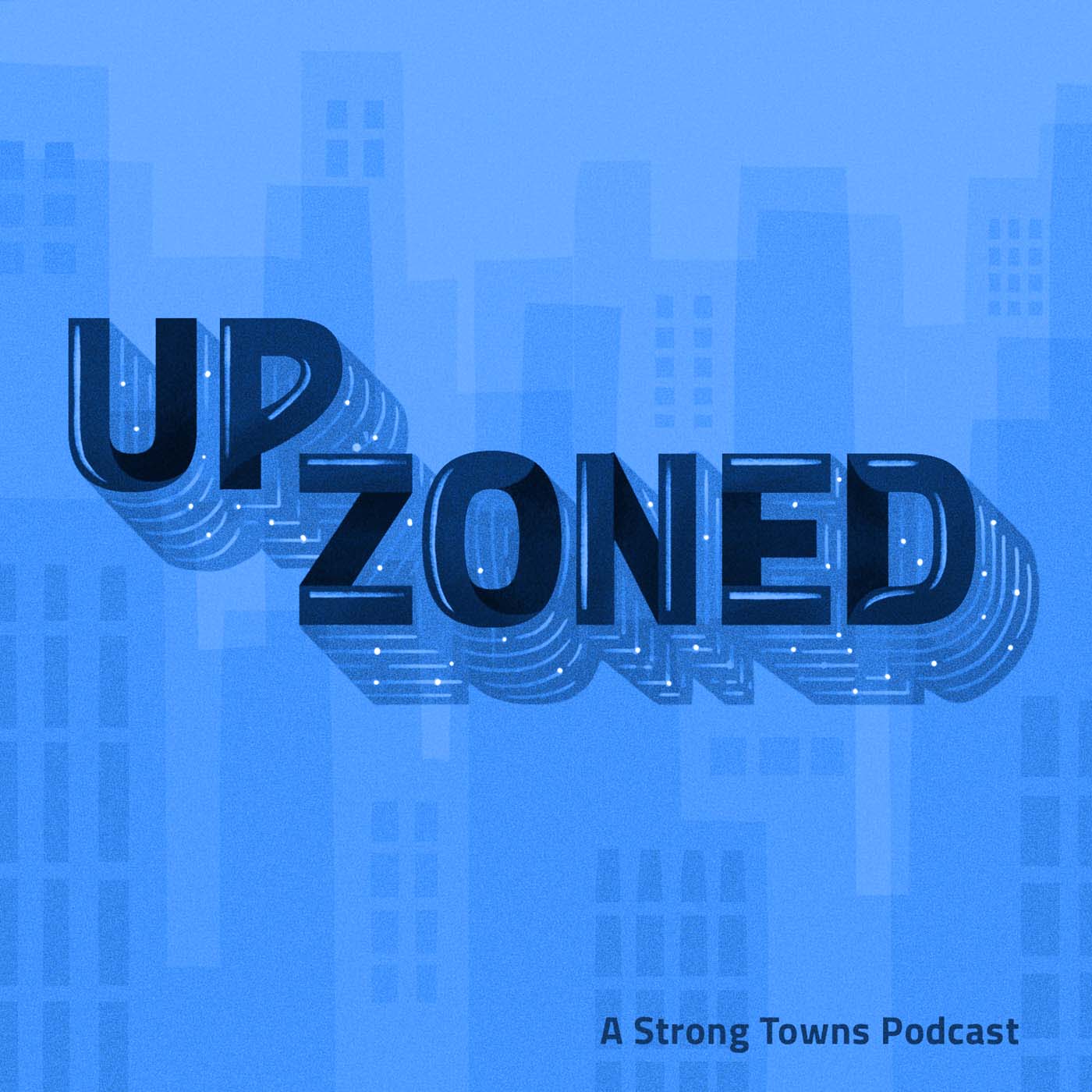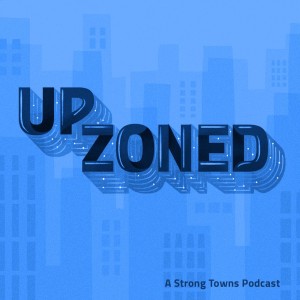
Sometimes, a hot new story will cross our desks that we need to talk about right away. That's where Upzoned comes in. Join Multistudio's Abby Newsham, Strong Towns President Chuck Marohn, and other guests to talk in depth about one big story from the week in the Strong Towns conversation, right when you want it: now.
Episodes

Wednesday Nov 22, 2023
Ryan Johnson: Builder of the First Car-Free Neighborhood Made From Scratch in the U.S.
Wednesday Nov 22, 2023
Wednesday Nov 22, 2023
Upzoned has been on a bit of a hiatus for the past couple of months, but we wanted to have at least one final episode of 2023 (and rest assured that the podcast will be returning with weekly episodes in 2024). This episode is an exciting one, as host Abby Kinney is joined by a guest whose work she’s been following for several years: Ryan Johnson, the builder and resident of the first car-free neighborhood built from scratch in the U.S., called Culdesac Tempe. We hope you enjoy this special end-of-the-year interview and look forward to more content coming soon!
ADDITIONAL SHOW NOTES

Wednesday Aug 23, 2023
Transportation Meltdown: Children on the School Bus Till 10 p.m.
Wednesday Aug 23, 2023
Wednesday Aug 23, 2023
Kentucky’s largest school system recently had to cancel the second and third day of classes due to what they're calling a disastrous overhaul of the bus system. On day one, some children were still on their bus at 10 p.m.
AP News reported this issue is partly the result of a bus driver shortage, which definitely plays a role in why Kentucky is having this transportation problem. But Kentucky isn’t the only place that’s struggled with getting children to and from school. There's more to the story, and it has to do with the suburban development pattern, and the closure of neighborhood schools.
In this Upzoned episode, host Abby Newsham digs into details of why, seemingly every year, many school districts have trouble with the transportation of students. She invites Dr. Michael Ralph, director of research at MultiStudio, and Daniel Herriges, Strong Towns’ editor-in-chief, to share their insights on the subject.
ADDITIONAL SHOW NOTES
-
“New school bus routes a ‘disaster,’ Kentucky superintendent admits. Last kids got home at 10 pm,” AP News (August 2023).
-
Learn more about the 2023 Local-Motive Tour.

Wednesday Aug 16, 2023
Is Affordable Housing Possible Under Current Zoning Laws?
Wednesday Aug 16, 2023
Wednesday Aug 16, 2023
Durham, North Carolina, is experiencing a hot debate over changing its zoning code.
The proposed “Simplifying Codes for Affordable Development” (or SCAD) presents tactical adjustments that focus on loosening the current rules so local people can make small-scale changes to their neighborhood. The changes would eliminate parking mandates, legalize smaller homes on smaller lots, and permit mixed-use development.
In this Upzoned episode, host Abby Newsham talks to Aaron Lubeck, who’s been closely involved in developing SCAD, about the proposed changes. They discuss why SCAD is such a controversial topic, and if it’s different from other reforms.
ADDITIONAL SHOW NOTES
-
“Op-Ed: The Purpose of Zoning is to Prevent Affordable Housing" by Bob Chapman, Indy Week (March 2023).

Wednesday Jul 26, 2023
Arizona Pushes for Suburban and Rural Development, Despite Dwindling Water Supply
Wednesday Jul 26, 2023
Wednesday Jul 26, 2023
State-level officials in Arizona are getting more serious about water scarcity issues, despite the still-booming growth pressures that exist there. Some listeners may remember from a story we covered in July 2022 that rural areas outside of Phoenix, like the Rio Verde foothills, have found it almost impossible to drill wells and are now facing challenges from having their water delivered by truck.
Now, the state has determined that there is not enough water for already-approved housing projects and will stop some developers from building if they rely too heavily on groundwater, given that it has become a finite resource. Arizona's allocation of Colorado River water is also being decreased due to drought, making alternatives quite limited. Still, the Arizona water agency has given permission to build 80,000 housing lots, and for the most part, construction is going to move forward on these lots.
On today's episode of Upzoned, Chuck and Abby discuss why this development pattern in Arizona—and most of the Southwestern United States—is, as you might have guessed, unsustainable.
ADDITIONAL SHOW NOTES
-
“Arizona Limits Construction Around Phoenix as Its Water Supply Dwindles,” by Christopher Flavelle and Jack Healy, The New York Times (June 2023).

Wednesday Jul 19, 2023
Atlanta’s New Idea To Address Their Housing Crisis
Wednesday Jul 19, 2023
Wednesday Jul 19, 2023
The United States is in the midst of a housing crisis. More and more cities are recognizing that part of the issue is due to restrictive zoning laws, which make building affordable homes a difficult feat.
On this episode of Upzoned, host Abby Kinney talks with the principal of Krongberg Urbanists and Architects, Eric Kronberg, on Atlanta’s new approach to addressing their housing issue. They’ll introduce the “social housing model” Atlanta plans to adopt, talk about the mixed-income housing aspects of Atlanta's plan, and explain what makes up a “Capital Stack.”
ADDITIONAL SHOW NOTES
-
“Atlanta plans to embrace ‘European-style social housing,’” by Sean Keenan, Atlanta Civic Circle (July 2023).

Wednesday Jul 05, 2023
The Invisible Reason for High Housing Prices: Restrictive Land-Use Regulations
Wednesday Jul 05, 2023
Wednesday Jul 05, 2023
It is extremely difficult to build housing in Rhode Island. It’s also expensive to buy homes, with prices having increased by 34% since the summer of 2020. Why? Adam A. Millsap makes the case in Forbes that because Rhode Island zoning laws are overly restrictive, developers are unable to meet the current and past needs of housing. Millsap writes:
“Places with fewer land-use regulations and more flexible zoning have lower housing prices and slower rent growth. Land-use regulations such as density restrictions, height restrictions, minimum lot sizes, parking requirements, and complicated set-back rules prevent developers from building more housing, especially more affordable housing.”
In this episode of Upzoned, join host Abby Kinney as she talks with guest Nolan Gray, author of Arbitrary Lines, about his perspective on zoning laws and Rhode Island’s efforts to address their housing crisis.
ADDITIONAL SHOW NOTES
-
“Zoning Reforms, Not Public Housing, Will Fix Rhode Island’s Housing Problem,” by Adam A. Millsap, Forbes (May 2023).
-
Arbitrary Lines: How Zoning Broke the American City and How to Fix It by Nolan Gray.

Wednesday Jun 28, 2023
Why Can’t We Have the “Perfect” Neighborhood?
Wednesday Jun 28, 2023
Wednesday Jun 28, 2023
“Who Can Afford America’s Perfect Neighborhood?” asks The Guardian. Longmont, Colorado, holds many elements of the American dream: tree-lined streets, neighbors walking to fulfill errands, children racing about, cafes, beautiful parks, gyms, and community events. To many, it sounds like a place of paradise. But housing prices have skyrocketed, and it’s not uncommon for a million-dollar home to sell in less than a week. In this Upzoned podcast, host Abby Kinney and co-host Chuck Marohn talk about this neighborhood and answer the question:
Why is this “perfect neighborhood” not easily copied in other places?
ADDITIONAL SHOW NOTES
-
“Who Can Afford America’s Perfect Neighborhood?” by Courtney Tenz, The Guardian (May 2023).

Thursday Jun 22, 2023
Behind the Scenes at the Strong Towns National Gathering
Thursday Jun 22, 2023
Thursday Jun 22, 2023
At the end of May, Strong Towns hosted its inaugural National Gathering in Charlotte, North Carolina. It was a two-day event packed with different speakers and sessions, where we heard from Strong Towns members about how they’re making incremental housing possible in their communities, how highways are destructive and how people are fighting expansions, how the property tax system is broken and what we can do about it, and so much more. In this Upzoned episode, host Abby Kinney goes behind the scenes with Strong Towns staffers Norm Van Eeden Petersman and Rachel Quednau. They chat about how the National Gathering came together, a few lessons learned, and some possible changes for future gatherings.
ADDITIONAL SHOW NOTES

Wednesday Jun 14, 2023
Live From the National Gathering
Wednesday Jun 14, 2023
Wednesday Jun 14, 2023
A few weeks ago, the first Strong Towns National Gathering took place in Charlotte, NC. While people buzzed back and forth between sessions, Upzoned host Abby Kinney sat at a table and invited those walking by to join her on the podcast. This week, you’ll hear Strong Towns members from all over talking about who they are, what they’ve seen in their communities, and what they’re doing.
Also, it’s Member Week at Strong Towns, and podcasts like Upzoned wouldn’t be possible without our members! Join today to support the movement and the advocates who are making our places stronger and more financially resilient.
ADDITIONAL SHOW NOTES
-
Note: When trying to make our communities a better place, we look for the “smallest next thing” that can be done. Strong Towns is no exception: it’s how we function as an organization. We’re always taking the smallest next step and learning as we go, and sometimes, it’s not perfect. The audio recorded for this podcast is an example. We experienced a handful of technical glitches and as a result, the audio is low quality, and sometimes difficult to hear. Because of all the people who put work into this episode, we opted to still publish despite the technical issues throughout. We hope you enjoy listening to people on the ground. Next year, we’ll be better prepared to record audio on site!

Wednesday May 17, 2023
Parking Regulations Threaten to Demolish Coffee Shop
Wednesday May 17, 2023
Wednesday May 17, 2023
In Kansas City, Kansas, parking regulations have threatened to demolish a local coffee shop for a parking lot. An out-of-state developer is trying to meet the city’s strict parking requirements for a new apartment complex across the intersection, and the coffee shop owner, T.J. Roberts, is trying to save what’s become a special community hub.
On this Upzoned episode, host Abby Kinney talks with Roberts about his inspiration for building community, and his struggle to keep his coffee shop, Kinship Cafe, from getting torn down. Also on the show is Dennis Strait, a principal at architect firm Multistudio, to talk about why city builders should care about a coffee shop over convenient parking spaces.
ADDITIONAL SHOW NOTES
-
“‘It’s heartbreaking.’ Why parking rules threaten one of KC area’s few Black coffee shops,” by Kevin Hardy, The Kansas City Star (May 2023).
